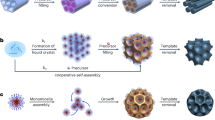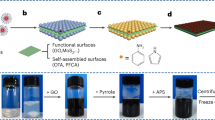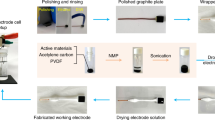Abstract
Nanostructured organic materials, particularly those constructed with uniform nanopores, have been sought for a long time in materials science1,2,3,4,5,6,7. There have been many successful reports on the synthesis of nanostructured organic materials using the so-called, 'supramolecular liquid crystal templating' route8,9,10,11,12,13. Ordered nanoporous polymeric materials can also be synthesized through a polymerization route using colloidal14,15 or mesoporous silica16,17 templates. The organic pore structures constructed by these approaches, however, are lower in mechanical strength and resistance to chemical treatments than nanoporous inorganic, silica and carbon materials. Moreover, the synthesis of the organic materials is yet of limited success in the variation of pore sizes and structures, whereas a rich variety of hexagonal and cubic structures is available with tunable pore diameters in the case of the inorganic materials18,19,20. Here we describe a synthesis strategy towards ordered nanoporous organic polymers, using mesoporous carbon as the retaining framework. The polymer–carbon composite nanoporous materials exhibit the same chemical properties of the organic polymers, whereas the stability of the pores against mechanical compression, thermal and chemical treatments is greatly enhanced. The synthesis strategy can be extended to various compositions of hydrophilic and hydrophobic organic polymers, with various pore diameters, connectivity and shapes. The resultant materials exhibiting surface properties of the polymers, as well as the electric conductivity of the carbon framework, could provide new possibilities for advanced applications. Furthermore, the synthesis strategy can be extended to other inorganic supports such as mesoporous silicas.
This is a preview of subscription content, access via your institution
Access options
Subscribe to this journal
Receive 12 print issues and online access
$259.00 per year
only $21.58 per issue
Buy this article
- Purchase on Springer Link
- Instant access to full article PDF
Prices may be subject to local taxes which are calculated during checkout




Similar content being viewed by others
References
Muthukumar, M., Ober, C.K. & Thomas, E.L. Competing interactions and levels of ordering in self-organizing polymeric materials. Science 277, 1225–1232 ( 1997).
Langley, P.J. & Hulliger, J. Nanoporous and mesoporous organic structures: new openings for materials research. Chem. Soc. Rev. 28, 279–291 ( 1999).
Wulff, G. Molecular imprinting in crosslinked materials with the aid of molecular templates-a way towards artificial antibodies. Angew. Chem. Int. Edn Engl. 34, 1812–1832 ( 1995).
Buchmeiser, M.R. New ways to porous monolithic materials with uniform pore size distribution. Angew. Chem. Int. Edn Engl. 40, 3795–3797 ( 2001).
Peters, E.C., Svec, F. & Fréchet, J.M.J. Rigid macroporous polymer monoliths. Adv. Mater. 11, 1169–1181 ( 1999).
Widawski, G., Rawiso, M. & François, B. Self-organized honeycomb morphology of star-polymer polystyrene films. Nature 369, 387–389 ( 1994).
Chen, Y.Y., Ford, W.T., Materer, N.F. & Teeters, D. Facile conversion of colloidal crystals to ordered porous polymer nets. J. Am. Chem. Soc. 122, 10472–10473 ( 2000).
Smith, R.C., Fischer, W.M. & Gin, D.L. Ordered poly(p-phenylenevinylene) matrix nanocomposites via lyotropic liquid-crystalline monomers. J. Am. Chem. Soc. 119, 4092–4093 ( 1997).
Pindzola, B.A., Hoag, B.P. & Gin, D.L. Polymerization of a phosphonium diene amphiphile in the regular hexagonal phase with retention of mesostructure. J. Am. Chem. Soc. 123, 4617–4618 ( 2001).
Zalusky, A.S., Olayo-Valles, R., Taylor, C.J. & Hillmyer, M.A. Mesoporous polystyrene monoliths. J. Am. Chem. Soc. 123, 1519–1520 ( 2001).
Zalusky, A.S., Olayo-Valles, R., Wolf, J.H. & Hillmyer, M.A. Ordered nanoporous polymers from polystyrene-polylactide block copolymers. J. Am. Chem. Soc. 124, 12761–12773 ( 2002).
Antonietti, M., Caruso, R.A., Göltner, C.G. & Weissenberger, M.C. Morphology variation of porous polymer gels by polymerization in lyotropic surfactant phases. Macromolecules 32, 1383–1389 ( 1999).
Lee, H.K. et al. Synthesis of a nanoporous polymer with hexagonal channels from supramolecular discotic liquid crystals. Angew. Chem. Int. Edn Engl. 40, 2669–2671 ( 2001).
Johnson, S.A., Ollivier, P.J. & Mallouk, T.E. Ordered mesoporous polymers of tunable pore size from colloidal silica templates. Science 283, 963–965 ( 1999).
Liu, L., Li, P.S. & Asher, S.A. Entropic trapping of macromolecules by mesoscopic periodic voids in a polymer hydrogel. Nature 397, 141–144 ( 1999).
Göltner, C.G. & Weissenberger,, M.C. Mesoporous organic polymers obtained by 'twostep nanocasting' Acta Polym. 49, 704–709 ( 1998).
Kim, J.Y., Yoon, S.B., Kooli, F. & Yu, J.S. Synthesis of highly ordered mesoporous polymer networks. J. Mater. Chem. 11, 2912–2914 ( 2001).
Corma, A. From microporous to mesoporous molecular sieve materials and their use in catalysis. Chem. Rev. 97, 2373–2419 ( 1997).
Ying, J.Y., Mehnert, C.P. & Wong, M.S. Synthesis and applications of supramolecular-templated mesoporous materials. Angew. Chem. Int. Edn Engl. 38, 56–77 ( 1999).
Barton, T.J. et al. Tailored porous materials. Chem. Mater. 11, 2633–2656 ( 1999).
Ryoo, R., Joo, S.H. & Jun, S. Synthesis of highly ordered carbon molecular sieves via template-mediated structural transformation. J. Phys. Chem. B 103, 7743–7746 ( 1999).
Jun, S. et al. Synthesis of new, nanoporous carbon with hexagonally ordered mesostructure. J. Am. Chem. Soc. 122, 10712–10713 ( 2000).
Ryoo, R., Joo S.H., Kruk, M. & Jaroniec, M. Ordered mesoporous carbons. Adv. Mater. 13, 677–681 ( 2001).
Joo, S.H. et al. Ordered nanoporous arrays of carbon supporting high dispersions of platinum nanoparticles. Nature 412, 169–172 ( 2001).
Lee, J.S., Joo, S.H. & Ryoo, R. Synthesis of mesoporous silicas of controlled pore wall thickness and their replication to ordered nanoporous carbons with various pore diameters. J. Am. Chem. Soc. 124, 1156–1157 ( 2002).
Ramsay, J.D.F, Kallus, S. & Hoinkis, E. SANS characterisation of mesoporous silicas having model structures. Stud. Surf. Sci. Catal. 128, 439–448 ( 2000).
Smarsly, B., Goltner, C.G., Antonietti, M., Ruland, W. & Hoinkis, E. SANS investigation of nitrogen sorption in porous silica. J. Phys. Chem. B 105, 831–840 ( 2001).
Wang, J., Musameh, M. & Lin, Y. Solubilization of carbon nanotubes by nafion towards the preparation of amperometric biosensors. J. Am. Chem. Soc. 125, 2408–2409 ( 2003).
Park, J.K. et al. In vivo nitric oxide sensor using non-conducting polymer-modified carbon fiber. Biosens. Bioelectron. 13, 1187–1195 ( 1998).
Smits, F.M. Measurement of sheet resistivities with the four-point probe. Bell System Tech. J. 711 ( May, 1958).
Acknowledgements
This work was supported in part by the Creative Research Initiative Program of the Korean Ministry of Science and Technology, and by the School of Molecular Science through Brain Korea 21 project. R.R. thanks O. Terasaki at Stockholm university for TEM measurements and helpful discussions.
Author information
Authors and Affiliations
Corresponding author
Ethics declarations
Competing interests
The authors declare no competing financial interests.
Supplementary information
Rights and permissions
About this article
Cite this article
Choi, M., Ryoo, R. Ordered nanoporous polymer–carbon composites. Nature Mater 2, 473–476 (2003). https://doi.org/10.1038/nmat923
Received:
Accepted:
Published:
Issue Date:
DOI: https://doi.org/10.1038/nmat923
This article is cited by
-
Nanostructuring one-dimensional and amorphous lithium peroxide for high round-trip efficiency in lithium-oxygen batteries
Nature Communications (2018)
-
Characterization of FeCo Nanoparticles Reinforced Natural Rubber using Nanomechanical Mapping
Journal of Wuhan University of Technology-Mater. Sci. Ed. (2018)
-
Encapsulation of Nickel Nanoparticles and Homopoly(Vinylsulfonic Acid) in Mesoporous Carbon CMK-3 as an Acid–Metal Bifunctional Catalyst for Tandem Reductive Amination
Journal of Cluster Science (2018)
-
Highly hydrophilic ordered mesoporous carbon–organic polymer composite and its applications in direct electrochemistry and the possibility of biosensing1
Journal of Applied Electrochemistry (2016)
-
Insights into the effect of structure-directing agents on structural properties of mesoporous carbon for polymer electrolyte fuel cells
Bulletin of Materials Science (2015)



